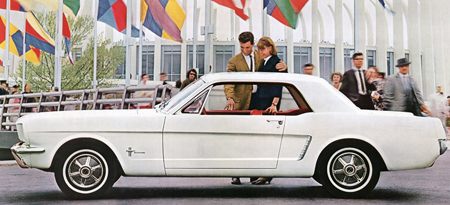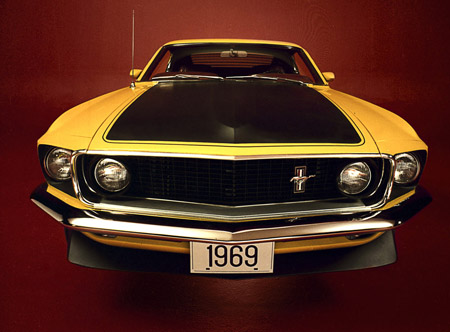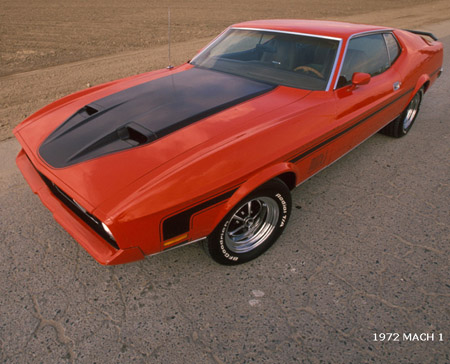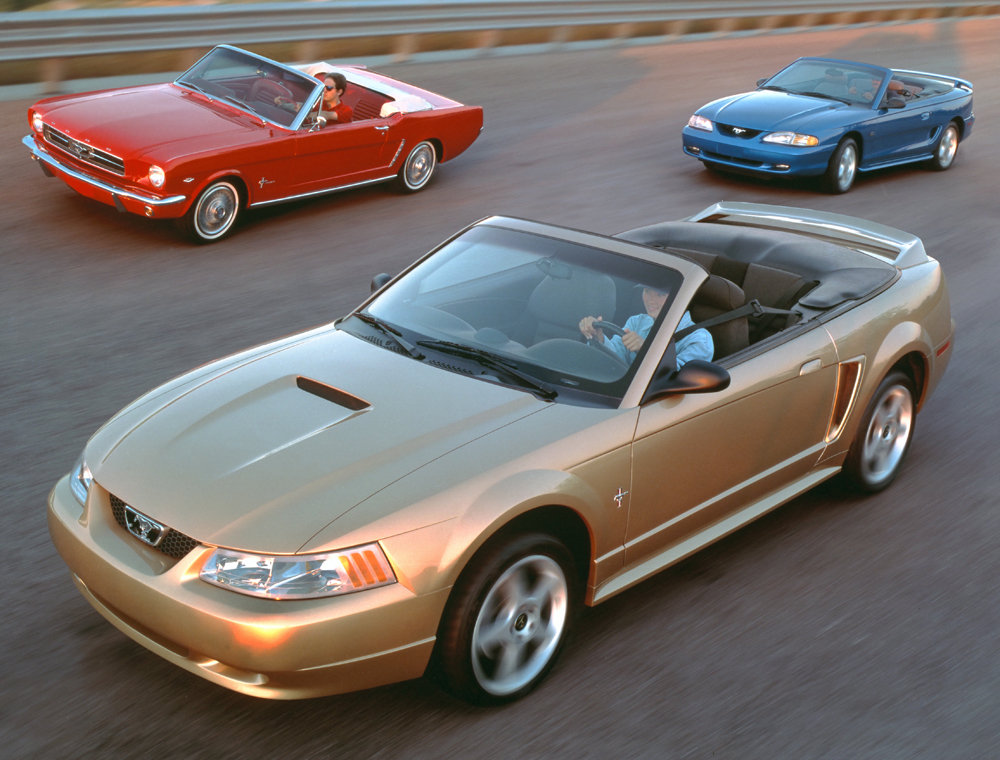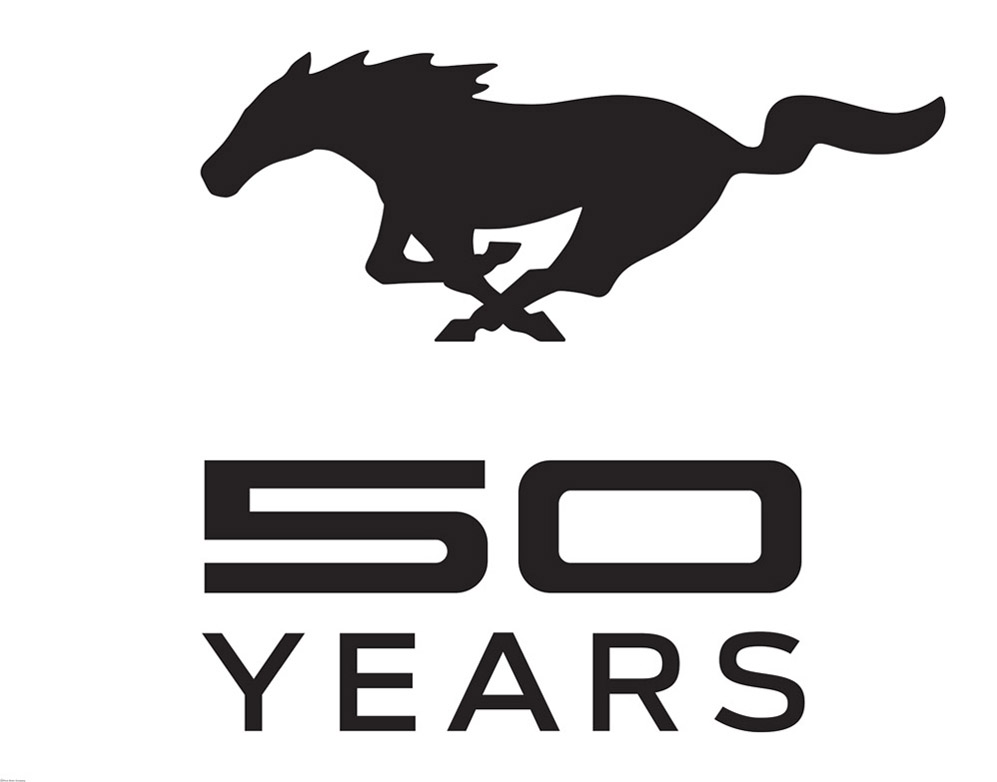|
YEARS OF MUSTANG MILESTONES
From Concept to Reality
19601963: Ford Motor Company decides to develop a fun-to-drive "personal car" that will appeal to the post-World War II "baby boom" generation. Ford's still-unnamed personal car is to be derived from the Ford Falcon. The winner of an in-house design competition establishes the classic "pony car" proportion: a long, sweeping hood, short rear deck and sharply sculpted flanks.
The first Mustang the 1962 Mustang I concept is a two-seat, mid-engine sports car named after the legendary P51 Mustang fighter plane from World War II. It made its debut in October at the United
States Grand Prix at Watkins Glen, New York where race driver Dan Gurney drove it around the circuit.

Generation I: 1964 ½ 1973
1964: The world debut of Mustang occurred at the 1964 World's Fair in
Flushing Meadows, New York on April 17, 1964. Standard equipment includes a 170-cubic-inch (cid) six-cylinder engine, three-speed floor-shift transmission, full wheel covers, padded dash, bucket seats and carpeting.
It weighed just 2,572 pounds. The price at launch: $2,368.
At the car's launch, the company expected annual sales of about 100,000 units. But 22,000 Mustang orders were taken on the first day, and sales reached an astounding 417,000 in car's first 12 months.
The first regular production Mustang was a Wimbledon White convertible with a 260-cid V-8 that rolled off the assembly line on March 9, 1964.
While on a promotional tour of Canada, a Ford dealer in St. John's, Newfoundland "mistakenly" sold the car to Capt. Stanley Tucker, a pilot
with Eastern Provincial Airlines. Ford reacquired the car from Capt. Tucker in 1966 in exchange for Mustang number 1,000,001, and the original car is now on display at The Henry Ford in Dearborn, Mich.

1965: The Shelby GT350 is introduced, with its 306-horesepower (hp), 289-cid V-8.
1966: Mustang sales pass the one million mark in March. A 1966 Mustang is the first and perhaps only car to park on the 86th floor observation
deck of New York's Empire State Building. In October 1965, Ford engineers disassembled a 1966 Mustang convertible and took it up in four sections using the building's passenger elevators.
1967: The 1967 model is considered by many to be the high water mark for Mustang design in the 1960s. The 2+2 model goes from a
semi-notchback to a sweeping full fastback roofline. Separate triple tail lamps, a longer nose and a bigger grille also are added for a more aggressive stance.
The Shelby GT500 goes on sale, powered by a massive 428-cid V-8 that produces 355 hp.
1968: The 302-cid V-8 replaces the "289" midyear, and a medium-riser version of Ford's premier race engine, the 427-cid V-8 (rated at 390 hp),
is offered as a $622 option. On April 1st, the 428 Cobra Jet engine is introduced as part of an option package aimed at enthusiasts.

1969: A "steed for every need" philosophy yields 11 different powertrain combinations. New models added to the lineup include the 290-hp Boss
302, the 375-hp Boss 429, the Mach 1 and the Grande luxury model. Also offered for the first time is the 351-cid "Windsor" V-8 engine, producing
250 hp with a two-barrel carburetor, or 290 hp with a four-barrel.
1970: A ram air "Shaker" hood scoop can be ordered on any Mustang equipped with a 351-cid or larger V-8.
1971: The 1971 cars are the biggest Mustangs ever nearly a foot longer and some 600 pounds heavier than the originals. Gone from the
lineup are the Boss 302, Boss 429, Shelby GT350 and GT500. The Boss 351, with its 351 "Cleveland" V-8 and Cobra Jet heads, debuts. The Mach
1 is available with a variety of powertrains, topped by the 370-hp 429 SCJ (Super Cobra Jet).
1972: Styling is unchanged from 1971, and the only new model offering is the Sprint a special red, white and blue exterior paint-and-tape package
with coordinated interior.
1973: The impact of gasoline shortages, rising insurance premiums and emissions controls brings the muscle-car era to a close. The 1973 model
year is the last for the original Falcon-platform Mustang. The convertible is discontinued.

Generation II: 1974 1978
1974: The completely redesigned Mustang II is introduced. Compared with the 1973 model, the Mustang II is 19 inches shorter and 490 pounds
lighter. It is available as a notchback, including a luxury Ghia model, and a 2+2 fastback. There are only two engine choices a 90-hp, 2.3-liter inline
four cylinder or a 100-hp, 2.8-liter V-6. For the first time, there is no V-8 engine and no Mustang convertible. Read more on the 1974 Mustang II From Sketch to Production, also The Mustang Story, the Case study that looks at the development of the original 1965 Mustang and 1974 Mustang II
1975: V-8 power returns to Mustang. But the 302-cid V-8 engine produces only 130 hp and comes only with an automatic transmission.
1976: The Cobra II package joins the lineup, replete with non-functional hood scoop, racing stripes and front and rear spoilers. Available in white
with blue stripes, blue with white stripes, and black with gold stripes, the Cobra II is intended to recall the looks of the famed Shelby Mustangs.
1977: In an attempt to appeal to convertible fans, fastback models are now available with T-Top removable glass roof panels. A new Sports
Performance Package finally adds a four-speed manual transmission to the 302-cid V-8.
1978: The new King Cobra model is the first Mustang to wear a "5.0" badge the metric equivalent of 302 cubic inches.

Generation III: 1979 -- 1994
1979: The new "Fox" platform Mustang makes its debut. The new model is longer and taller than Mustang II, yet is 200 pounds lighter. A sleek, "Euro"
design replaces many traditional Mustang styling cues. Engine choices are a 2.3-liter four-cylinder (including a 140-hp turbo version), a 2.8-liter V-6, a 3.3-liter inline six-cylinder and a 140-hp 5.0-liter V-8.
1980: The 302-cid V-8 engine is dropped and is replaced by an economy-minded 119-hp, 255-cid V-8 derivative.
1981: Performance heads to the back burner, as the turbo four-cylinder is dropped from the Mustang engine lineup, and new emissions controls drop
the 255-cid V-8's power to 115 hp.
1982: The Mustang GT returns after a 12-year absence. Also back is the 5.0-liter V-8, rated at 157 hp. Optional T-Tops return.
1983: After 10 years, Mustang again has a convertible model, complete with power top and a tempered glass back window. The Mustang GT's
5.0-liter V-8 is now rated at a healthy 175 hp.
1984: Ford's Special Vehicle Operations creates the Mustang SVO. It features a front fascia with integral fog lamps, an off-center functional
scoop and a polycarbonate dual-wing rear spoiler. Power is from a turbocharged and air-to-air intercooled 2.3-liter inline four-cylinder producing 175 hp and 210 foot-pounds (lb.-ft.) of torque. Also available is
the 20th Anniversary Edition Mustang, a special V-8 powered GT model painted in Oxford White with Canyon Red interior. It can be had in coupe or convertible form.
1985: Mustang gets a revised 5.0-liter HO (high output) V-8 that makes 210 hp when mated to a manual transmission. A new Quadra-Shock rear
suspension helps provide better acceleration by reducing wheel-hop on hard takeoffs.
1986: Mustang's V-8 trades its carburetor for new sequential multi-port fuel injection.
1987: Mustang is heavily restyled, with a new "aero-look" body. The 5.0-liter V-8 now produces 225 hp.
1989: For Mustang's 25th anniversary, all cars produced between April 17, 1989, and April 17, 1990, sport the familiar running horse on the dashboard
with "25 years" inscribed underneath.
1990: Mustang now sports a driver's-side airbag as standard equipment.
1991: Entry-level Mustangs receive an improved 105-hp, twin-plug 2.3-liter four-cylinder with distributorless ignition. All V-8 models now come
with new, five-spoke 16x7-inch cast aluminum wheels.
1992: The stealthy Mustang LX 5.0 develops a cult following and outsells all other models combined. Wire-style wheel covers and whitewall tires
disappear from the options list.
1993: Ford's new Special Vehicle Team (SVT) introduces the limited-production SVT Mustang Cobra with subtle but distinctive styling
cues and performance upgrades. The low-volume 1993 Cobra R, developed to be used as a race car, sells out prior to production.

Generation IV: 1994 2004
1994: For its 30th anniversary, Mustang is dramatically restyled to evoke the car's heritage and performance tradition. Fully 1,330 of the vehicle's
1,850 parts are changed. The new FOX-4 platform is thoroughly re-engineered and structurally stiffer. The hatchback bodystyle is dropped, leaving the two-door coupe and convertible. The GT's 5.0-liter
V-8 engine produces 215 hp. An SVT Mustang Cobra is launched mid-year, producing 240 hp from its upgraded 5.0-liter V-8.
1995: The final model year for the venerable 5.0-liter V-8, which began life as the 260- and later 289-cid small-block engines. The second SVT
Mustang Cobra R is introduced 250 units, street legal but meant for racing with a 300-hp, 5.8-liter V-8 and five-speed manual transmission.
|






